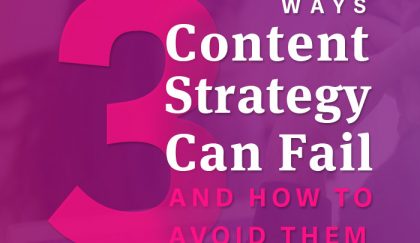3 Ways Content Strategy Can Fail (and How to Avoid Them)

Let’s assume your organization has developed and implemented a content strategy. Great! You are ahead of a significant number of organizations already. Hopefully, with this strategy, your team has prepared a list of content which needed to be created, the process on how to create it, and a calendar identifying publishing dates for your content.
Your plans may have gone smoothly at first. Eventually, the bubble pops and you find that no one is sharing your content, no one is clicking, and no one cares. What could have gone wrong? Before you worry about your job security, take a breath. These are solvable issues that may have come from an oversight of simple, but crucial aspects of content strategy.
1. Focusing on Quantity Over Quality.
We get it. The more relevant keywords you attach to your content, the better. You want to push your visibility to the first results page in Google. Improving SEO is a key part of an overall content strategy. However, companies will likely fail at their strategy if they focus too much on SEO and churning out blog after blog. We’ve seen companies that rank near the top of a Google search on one relevant issue, but as soon as you click through you realize the content is mostly fluff and no substance. These companies can quickly lose out on their reputation as industry and thought leaders.
An indication that your content is not working is people not reading or engaging. Your content writers should create products which are of significant interest and assistance to your target audiences. Gain a better understanding of what kinds of content your audiences share on social media and sign up to receive email updates for. Learn from competitors and comparative industries on how and where their content is succeeding.
True content strategy creates meaningful content. Great writing requires serious strategy and investment. Take time to understand your target audiences and construct a distinct brand voice. If you do not have a team of in-house writers, consider investing in an experienced freelancer or content creation service.
2. Ignoring the Silo Problem.
The content strategy has been written, creation and entry processes have been established. But if your company has a problem with “silos” or teams that rarely work outside of their department, you can easily run into problems with content implementation. Even small businesses can run into clashing opinions and rogue coworkers. Here are a few ways your content strategy can be undermined by ineffective implementation:
- Unauthorized edits to content in CMS due to multiple access points.
- Internal teams creating their own landing pages / social media accounts with their own brand tone.
- Endless revisions due to competing opinions on who should “sign off”.
- Last-minute, expert-less content creation due to lax enforcement of content calendar.
- Grievances and power struggles being played out in whose content gets “featured”.
The silo problem is an institutional problem. While encouraging collaboration and communication between teams is important to build content strategy, every organization should address inter-team communication outside of creating content. Conduct regular inter-team meetings to discuss individual team goals. Find opportunities for each team to contribute to and invest in overall business goals. If you can build trust in the aims of your institution, your teams will be more willing to collaborate in maintaining your content strategy rather than seek to work outside of it.
3. Restricting Your Content Strategy to Blogs
Traditionally, brands have relied on long-form content to showcase their thought leadership and provoke conversation in the digital realm. However, many organizations make the mistake of equating a robust content strategy to blogs. Blogs may not always be the most appropriate way to engage your audiences.
As social media and short-form visual content platforms like SnapChat and Instagram continue to increase in popularity, companies need to be taking advantage of the diversity of content opportunities. Remember, content is not just text; content is also multimedia and visual components. Your content should match expert visual design principles with masterful storytelling techniques. If you do have text, it should be complemented by photos, videos, and graphics.
Learn more about what types of content best engage your audiences. Perhaps you should not publish blogs; maybe your audience prefers expert whitepapers or webinars. Either way, your audience will more likely engage with your brand if your content strategy incorporates their needs and preferences. Alternatively, organizations might focus too much on sharable content creation rather than polishing other digital content like their websites’ landing pages.
Aim From Your Strengths, Even When You Fail
When all else fails, rely on your strengths. Identify what makes your organization unique and energizing, and funnel that motivation into your content strategy.
Remember that your content strategy should be an evolving one. The success or failure of content can always be measured. Be mindful of your content goals and implement the correct tools to track your impact. Luckily, if you catch what is not working with your content strategy early enough, you can put it back on track with the right adjustments.
Want to learn more about updating your digital strategy in 2017? Check out our latest expert insight or consult our content strategy team.

